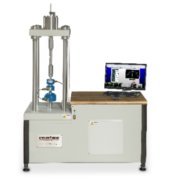Load Cell Basics Technical Q&A Part One
 Interface recently hosted a webinar, Load Cell Basics, where our experts answered a series of questions from event attendees. In the interest of sharing what we know and addressing some frequently asked inquiries, we are offering a new series in our Interface IQ blog entitled Interface Technical Q&A. At the conclusion of our presentation, we had several questions related to the basics of load cells. We will be answering them in two posts. Here is the first list.
Interface recently hosted a webinar, Load Cell Basics, where our experts answered a series of questions from event attendees. In the interest of sharing what we know and addressing some frequently asked inquiries, we are offering a new series in our Interface IQ blog entitled Interface Technical Q&A. At the conclusion of our presentation, we had several questions related to the basics of load cells. We will be answering them in two posts. Here is the first list.
Why Does Interface Use Proprietary Strain Gages?
Strain gages are a key component to any load cell. Making our own strain gages gives Interface full control over our design and production, ensuring we can meet our specifications with certainty in quality, accuracy, and dependability. Interface strain gages are precision matched to the load cell material to counteract the temperature effect on output. We have different load cell materials and that means we use different strain gages for each type.
Our strain gages are simple in design, and we don’t use compensation resistors making them a more reliable circuit. They don’t have to go through resistors; thus, the accuracy and precision measurement is more reliable and capable of faster thermal and higher outputs.
What Type of Temperature Testing Do You Do on Interface Load Cells?
Interface performs both hot and cold thermal compensation from 15˚ – 115˚F, including adjust and verify cycle. Most other manufacturers of load cells provide only the hot side (60˚ – 160˚F) testing. The slope of the curve is much flatter near room temperature and identical at both ends of the slope. The result is minimal variation across the entire thermal range. We also offer custom calibrated ranges by request. Read more about temperature compensation here.
Is Temperature Compensation Achieved Using Dummy Gages?
The simple answer is no. Interface does temperature compensation of output by matching the strain gage to the material temperature compensation of zero. This is achieved by using a wire in the circuit that opposite resistance changes to the circuit.
Do You Have Software to Read TEDS Available to Use with Interface Load Cells?
Interface does offer instruments that can use the TEDS data and instruments that can write the TEDS data to the chip. Interface has software that hooks up or attaches to the TEDS chip reader writer so that when we program a chip during manufacturing of load cells in our factory, we have software we use to complete this function. We also do offer this software for commercial use.
Is it Acceptable to Regularly Use a Load Cell Above Its Specified Capacity?
The short answer is no. You want to reserve the “above capacity” for accidents. We are aware that people will do this in practice and the load cell will typically work reasonably well above capacity. The problem is you want to handle that the answer is no you’re consuming your safety factor and you don’t have any extra head room for something that goes wrong. Also, using the load cell above capacity doesn’t exactly follow the same calibration curve. As an example, if you are using a 10k load cell with a 10k calibration and you are running tests at 12k, you may have higher errors. You can ask us to calibrate the load cell to the 12,000 lbs.; however, you must note this can reduce the safety factor and that is why we do not recommend it.
Does Variable Altitudes Impact Performance?
Interface does have the ability to handle different pressure scenarios. Interface sends our products out ventured, if necessary, to be able to tolerate pressure change without causing any zero shift. If you do have applications where you will have either high pressure requirements or pressure change throughout the test, we certainly have solutions that can accommodate that requirement. Work with your application engineer to ensure you have the exact testing requirements detailed when you are ready to buy your next load cell.
Can Cables Influence Temperature Errors?
If you’re adding cable to the load cell and for example, you have a 10-foot cable you want to add 100 feet more of cable, that adds resistance. The lower gauged cable, the better. A 22-gauged cable is better than a 28-gauged cable, so use a thicker cable and it will have less resistance impact on the measurement.
Is Creep Due to Material or Strain Gages?
Essentially all the elements in the sensor and everything mechanical will respond to creep. The goal is to match the creep behavior of the bridge to the creep behavior of the load cell material or the flexure. Yes, creep affects both, but you want the result to trend in the same direction so that you get minimal error or change in the signal because of creep.
Are All Load Cells Intrinsically Safe?
They are intrinsically safe devices; however, anytime there is a hazardous environment or intrinsic safety requirements, please contact an application engineer to review the sensor use case and to factor in all aspects of your testing and use environment. The load cells are typically working off 5-volt 10-volt and you need to look at all aspects of the location. For more information about our specialized line visit load cells for harsh environments.
This is the first in a new series of Interface Technical Q&A. Do you have a question for our technical experts? Send an email to digmktg@interfaceforce.com and we will add it to a future post. If you have an immediate question, be sure to contact us today and let us know how we can support you. You can also reference our technical support resources online for help.
Contributors: Keith Skidmore and Brian Peters
Additional Resources








